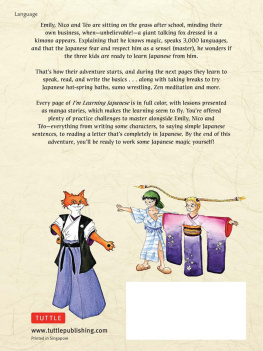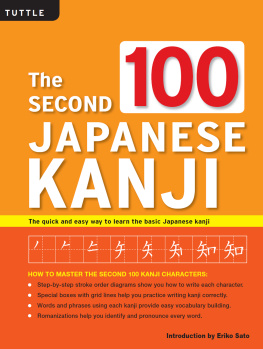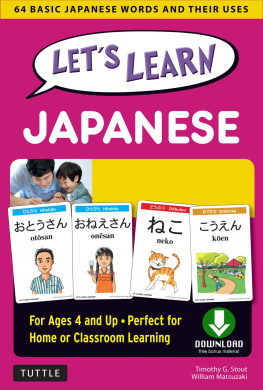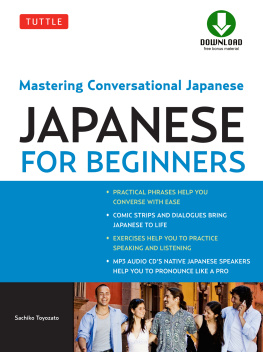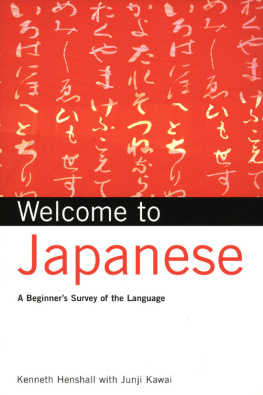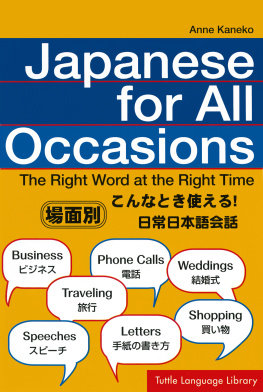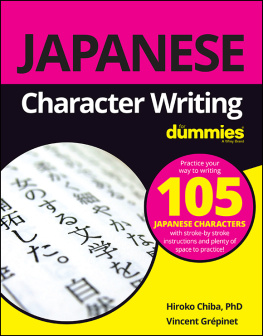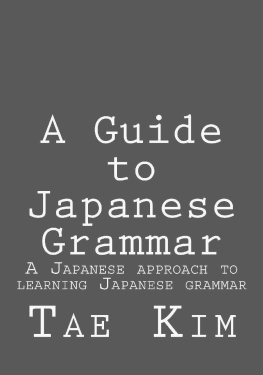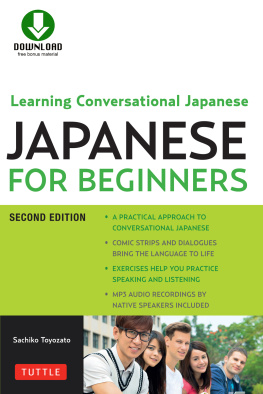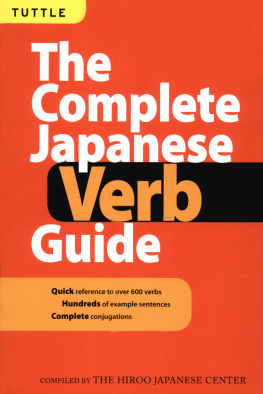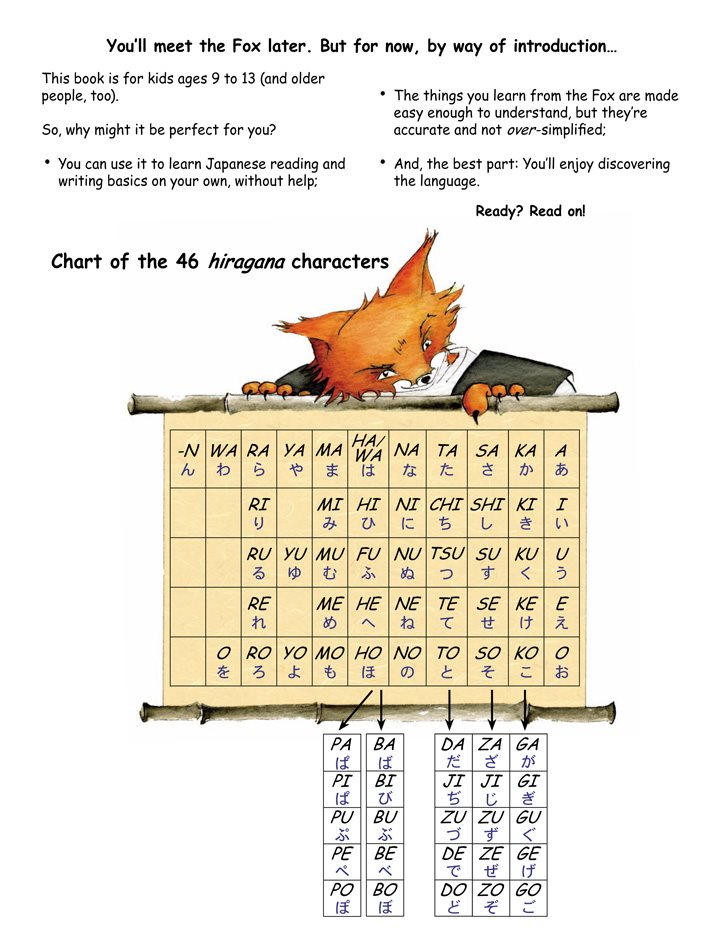Table of Contents
Guide
Christian Galan Illustrated by Florence Lrot-Calvo
IM LEARNING
JAPANESE
LEARN TO SPEAK, READ AND WRITE THE BASICS
Im Learning Japanese
Character Writing Practice Sheet
You may dowload a PDF of this writing practice sheet at www.tuttlepublishing.com
CONTENTS
Making Sentences with
, and ................................................ 21
CHAPTER 1: Learning All About Japan
Whats he saying
What the heck?
A fox dressed
in a skirt
He doesnt look
very... um...
easygoing...
Its Japanese. I was saying
that my name is Kitsune.
Kitsune means fox. Since I
teach Japanese, people call
me Kitsune sensei . Sensei
means master or teacher
and is pronounced sen-say
And I was asking how you
were all doing.
Up till now,
okay
Shh
Master Fox, eh?
It reminds me
of that Aesops
fable, the Fox
and the grapes.
Do you eat
grapes?
By the way, how
come you can
speak English?
I know more than 3,000 languages.
I am a magical being, gifted with
many powers and the Japanese fear
and respect me And so should
you because I can hear everything
thats said behind my back. So are
you game to study Japanese with me?
What do you
think, since were
in this book?
3,000 languages!
Cool And me
who even has
trouble with
English Can I
become a fox?
Magical, I mean
What about
Swahili? Can you
speak Swahili
too?
Stop it, were
gonna get in
trouble
Before we
begin, I have to
introduce you
to Tanuki-san,
who will be my
assistant in this
book and who
will give you
lots of good
advice
Hello,
children
And Id like everyone
to introduce
themselves and say
why you want to
study Japanese.
Hello, Tanuki-san.
My name is Emily,
Ive practiced aikido
since I was little,
and Id love to go
to Japan someday
Im To. I
love manga
and anime
And Im crazy
about sumo
wrestling
contests on
cable TV
Me, Im Nicolas, but
everyone calls me
Nico. Im friends with
To and, uh, Emily
too I mean, uh
I was just hanging
around, I dont even
know where Japan is
I really like soccer
though But that
probably has nothing
to do with this book
Japan, is that where
theres a big wall?
The Great Wall? no, thats in
China Do you ever read anything
besides the sports section?
Are you two ever
going to shut up?
You will learn
with me how to
read and write in
Japanese and how
to make your own
sentences. I will
also give you some
facts about Japan
and its inhabitants
It looks like that
could be useful to
some of you
Right, are you
ready? We will
start with
how Japanese
writing works
The Japanese use two sorts of characters to write their
language: kanji and kana . kana (which includes two sets of
symbols, Hiragana and katakana ) are the characters used
to transcribe syllables: a, i, u, e, o ka, ki, ku, ke, ko
sa, shi, su, se, so There are 46 Hiragana characters in
all, as you can see in the chart below.
The chart starts
here, with the
syllable a ; First
the first column,
then the second,
and so on.
As for the kanji , they are characters that
can each have several readings and several
meanings. Unlike hiragana , there are several...
thousand!!! The Japanese use hiragana and kanji
side by side and in a complementary way.
AaGh!! Several thousand
kanji ! forget it.
Sir Fox, can we leave this
book, right now?
Yikes! 46 characters? thats
almost twice as many
letters as our alphabet!
Nobody leaves Dont panic! Well proceed just like the young
people in Japan do to learn to read and write. First, well learn
hiragana and then, little by little, kanji. Anyway, youll see, hiragana
are great characters since not only do they allow us to write all
the words of the Japanese language, but also, once you have learned
them, youll be able to use them easily because each character
corresponds to only one syllable.
And, the reverse also: each syllable is
always written with the same hiragana.
In comparison, think about how many
ways there are to write down the sound
o in English!
o, ow,
oe,
oa, oh,
ough
Slow down, I cant
write that fast
But whyre you writing
it down, its all printed
on the page, fool!
Fool?
while we discover
hiragana, well also
begin to see how
Japanese sentences
work, and Im not
going to lie to you
they dont work at
all like in English!
I wanna go!
Dont feel
well now
Tummy ache
Sir, sir, can I
go pee?
Sentences work
backwards.
What do you
expect, Japan
is on the other
side of the
world. Their
heads are
upside down
Tsk, tsk Not at all, Nico.
Japan is certainly very far
away from America, but in
the same hemisphere So
they dont at all have their
heads upside down
I think it is urgent,
before we go any
further, to clarify
for Nico where Japan
is, and to give him
some facts about my
country.
Japan is located in Far
East Asia, meaning at
the extreme Eastern
end of the Asian
continent. Japan is
also called the Land
of the Rising Sun,
which is represented
on the Japanese flag.
Japan is made up of thousands of islands:
its what we call an archipelago. The four
main islands are Hokkaido, Honshu, Shikoku
and Kyushu. The capital city is Tokyo.
The highest mountain is Mount Fuji ( Fujisan) ,
12,388 feet (3776 meters) high. There are
around 127 million inhabitants, less than
half as many as in the United states.
To get back to our subject,
lets take for example the
sentence:
Ah! The cat is eating a mouse!!!
Youre faking!
Its all on
purpose!
Teachers pet!
In English, its the placement of the word within the sentence that tells you which one of the words is the subject, which one is the direct object, etcetera. If you say for instance The mouse is eating the cat it can either mean that were dealing with a monstrous mouse, or with an animated movie or that the sentence isnt working
In Japanese on the other hand, the word placement within the sentence doesnt matter, except for the verb, which is always at the end. Indeed, nouns are followed by little words of one or two syllables, called particles . Those particles are the ones that indicate the function of the nouns in the sentence. Its as if you said in English:
Cat (subject) + mouse (direct object) + eating.
in japanese You can also say, for the exact same message:
Mouse (direct object) + cat (subject) + eating.
These functions are the same as in English, so youll have to remember whatever grammar you learned at school. Well be talking about subjects, verbs, direct objects, and so on.

